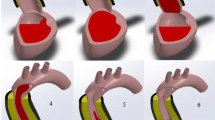Abstract
The performance of intra-aortic balloon pumping is assessed on the basis of a mock circulation and a theoretical model of arterial pulse propagation. The parameters investigated include timing of onset and speed of inflation and deflation as well as pumped air volume. The models used do not contain any active peripheral elements with regulatory capabilities and so the simulated heart adjusts its stroke volume mechanically according to the operating conditions. The observed and calculated changes of typical quantities in terms of ‘stroke’ volume, ‘LV’, ‘aortic’ and ‘peripheral’ pressures are to be attributed, therefore, to the influence of the mechanical pump operation without physiological reactions of the circulatory system as a whole. It is found that timing details of the counterpulsation have a minor influence on the overall mechanical pump performance. Accordingly, the influence of physiological reactions of the cardiovascular system to changes in pump operation seems to be far more important than the one caused by the purely mechanical changes themselves. However, rapid inflation and deflation of the balloon may be accompanied by severe opening or closing shocks, respectively.
Similar content being viewed by others
References
Anliker, M., Rockwell, R. L. andOgden, E. (1971) Nonlinear analysis of flow pulses and shock waves in arteries.J. Appl. Math. Phys. (ZAMP),22, 217–246.
Anliker, M., Stettler, J. C., Niederer, P. andSchilt, W. (1978) Optimal operation of intra-aortic balloon pumps.Proc. Europ. Soc. Art. Organs (ESAO),V, 116–120.
Holenstein, R., Niederer, P. andAnliker, M. (1980) A viscoelastic model for use in predicting arterial pulse waves.J. Biomech. Eng.,102, 318–325.
Jaron, D., Tomececk, J., Freed, P., Welkowitz, W., Fich, S. andKantrowitz, A. (1970) Measurement of ventricular load phase angle as an operating criterion for in-series assist devices: hemodynamic studies utilizing intra-aortic balloon pumping.Trans. Am. Soc. Artif. Int. Organs,16, 466–471.
Jaron, D., Moore, T. W. andPing, H. (1985) Control of intraaortic balloon pumping: theory and guidelines for clinical applications.Ann. Biomed. Eng.,13, 155–175.
Kao, C. andOhley, W. J. (1982) Influence of vascular parameters on the effectiveness of intra-aortic balloon pumping: a model study.Med. & Biol. Eng. & Comput.,20, 529–538.
Kulinski, W. S., Jaron, D., Ohley, W. J. andGreenall, R. K. (1984) The intra-aortic balloon pump: a nonlinear digital computer model.J. Biomech. Eng.,106, 220–228.
Lorenz, G. (1973) Über die Wellenausbreitung in viskoelastischen Leitungen und ihre gasdynamische Analogie. Diss. TH Aachen.
McMahon, T. A., Clark, C., Murthy, V. S. andShapiro, A. H. (1971) Intra-aortic balloon experiments in a lumped-element hydraulic model of the circulation.J. Biomech.,4, 335–350.
Müller, A. (1950) Über die Fortpflanzungsgeschwindigkeiten von Druckwellen in dehnbaren Röhren bei zunehmender und strömender Flüssigkeit.Helv. Physiol. Acta,8, 228–241.
Müller, A. (1959) Die mehrschichtige Rohrwand als Modell für die Aorta.,17, 131–145.
Murthy, V. S., McMahon, T. A., Jaffrin, M. Y. andShapiro, A. H. (1971) The intra-aortic balloon for left heart assistance: an analytical model.J. Biomech.,4, 351–367.
Nerz, A. R., Myerowitz, P. D. andBlackshear, P. L., (1979) A simulation of the dynamics of counterpulsation.J. Biomech. Eng.,101, 105–111.
Niederer, P. (1985) Damping mechanisms and shock-like transition in the human arterial tree.J. Appl. Math. Phys. (ZAMP),36, 204–220.
Philippe, E., Clark, J. W., Lande, A. andEllis, J. R. (1980) Microprocessor control of intra-aortic balloon pumping.Ann. Biomed. Eng.,8, 209–224.
Schilt, W., Freed, P. S., Khalil, G. andKantrowitz, A. (1967) Temporary non-surgical intraarterial cardiac assistance.Trans. ASAIO,12, 322–327.
Stettler, J. C., Niederer, P. andAnliker, M. (1981) Theoretical analysis of arterial hemodynamics including the influence of bifurcations. Parts I and II.Ann. Biomed. Eng.,9, 145–175.
Williams, M. J., Rubin, J. W. andEllison, R. G. (1977) Experimental determination of optimum performance of counterpulsation assist pumping under computer control.Comput. & Biomed. Res.,10, 545–559.
Author information
Authors and Affiliations
Rights and permissions
About this article
Cite this article
Niederer, P., Schilt, W. Experimental and theoretical modelling of intra-aortic balloon pump operation. Med. Biol. Eng. Comput. 26, 167–174 (1988). https://doi.org/10.1007/BF02442260
Received:
Accepted:
Issue Date:
DOI: https://doi.org/10.1007/BF02442260




